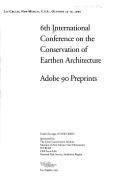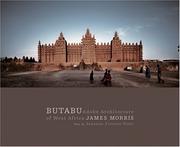| Listing 1 - 10 of 42 | << page >> |
Sort by
|
Book
Year: 1974 Publisher: Sante Fe: Museum of New Mexico,
Abstract | Keywords | Export | Availability | Bookmark
 Loading...
Loading...Choose an application
- Reference Manager
- EndNote
- RefWorks (Direct export to RefWorks)

ISBN: 0892361816 Year: 1990
Abstract | Keywords | Export | Availability | Bookmark
 Loading...
Loading...Choose an application
- Reference Manager
- EndNote
- RefWorks (Direct export to RefWorks)
On October 14-19, 1990, the 6th International Conference on the Conservation of Earthen Architecture was held in Las Cruces, New Mexico. Sponsored by the GCI, the Museum of New Mexico State Monuments, ICCROM, CRATerre-EAG, and the National Park Service, under the aegis of US/ICOMOS, the event was organized to promote the exchange of ideas, techniques, and research findings on the conservation of earthen architecture. Presentations at the conference covered a diversity of subjects, including the historic traditions of earthen architecture, conservation and restoration, site preservation, studies in consolidation and seismic mitigation, and examinations of moisture problems, clay chemistry, and microstructures. In discussions that focused on the future, the application of modern technologies and materials to site conservation was urged, as was using scientific knowledge of existing structures in the creation of new, low-cost, earthen architecture housing.
Book
ISBN: 2857060009 9782857060000 Year: 1985 Publisher: Amiens: Archives départementales de la Somme,
Abstract | Keywords | Export | Availability | Bookmark
 Loading...
Loading...Choose an application
- Reference Manager
- EndNote
- RefWorks (Direct export to RefWorks)
Book
Year: 1958 Publisher: Delhi National building organisation
Abstract | Keywords | Export | Availability | Bookmark
 Loading...
Loading...Choose an application
- Reference Manager
- EndNote
- RefWorks (Direct export to RefWorks)
Building, Adobe --- Walls --- Waterproofing
Book
ISBN: 3792709112 Year: 1986 Publisher: Köln Rheinland-Verlag
Abstract | Keywords | Export | Availability | Bookmark
 Loading...
Loading...Choose an application
- Reference Manager
- EndNote
- RefWorks (Direct export to RefWorks)

ISBN: 0804006342 Year: 1974 Publisher: Chicago Sage Books
Abstract | Keywords | Export | Availability | Bookmark
 Loading...
Loading...Choose an application
- Reference Manager
- EndNote
- RefWorks (Direct export to RefWorks)

ISBN: 1568984138 Year: 2004
Abstract | Keywords | Export | Availability | Bookmark
 Loading...
Loading...Choose an application
- Reference Manager
- EndNote
- RefWorks (Direct export to RefWorks)
Many think that sub-Saharan African architecture is little more than mud huts. Mud, yes--but certainly not huts. Instead, these adobe buildings, many of them enormous, show sublime sculptural beauty, variety, ingenuity, and originality. In the Sahal region of western Africa--Mali, Niger, Nigeria, Togo, Benin, Ghana, and Burkina Faso--people have been constructing earthen buildings for centuries. But they remain unknown to most of the Western world. Their plastic forms--from simple stairways, to ornamented domes, to complex arches--are highlighted by subtle painting and intricate grillwork. James Morris spent four months photographing these hidden jewels, from the great mosque at Djenne--the largest mud building in the world--to small houses in remote animist communities. 'Butabu' shows these works as both aesthetic treasures and as architecture with contemporary relevance. These are no museum pieces, but rather buildings that continue to be maintained and built, even as they are threatened by the uncertainties of weather and the encroachment of Western technology. Text by Suzanne Preston Blier covers the history of earthen architecture, the technology that creates it, and the symbolism of its form.
Architecture --- Building, Adobe --- Africa [West ] --- Building [Adobe ] --- Construction en adobe
Book
Year: 1989 Publisher: New York, NY : Aperture Foundation,
Abstract | Keywords | Export | Availability | Bookmark
 Loading...
Loading...Choose an application
- Reference Manager
- EndNote
- RefWorks (Direct export to RefWorks)
Book
ISBN: 1555905072 Year: 1987 Publisher: Monticello (Ill.): Vance bibliographies
Abstract | Keywords | Export | Availability | Bookmark
 Loading...
Loading...Choose an application
- Reference Manager
- EndNote
- RefWorks (Direct export to RefWorks)
Building, Adobe --- Pisé --- Bibliography --- Bibliography
Book
ISBN: 9004356339 Year: 2018 Publisher: Leiden, Boston: Brill,
Abstract | Keywords | Export | Availability | Bookmark
 Loading...
Loading...Choose an application
- Reference Manager
- EndNote
- RefWorks (Direct export to RefWorks)
This edited volume follows the panel “Earth in Islamic Architecture” organised for the World Congress for Middle Eastern Studies (WOCMES) in Ankara, on the 19th of August 2014. Earthen architecture is well-known among archaeologists and anthropologists whose work extends from Central Asia to Spain, including Africa. However, little collective attention has been paid to earthen architecture within Muslim cultures. This book endeavours to share knowledge and methods of different disciplines such as history, anthropology, archaeology and architecture. Its objective is to establish a link between historical and archaeological studies given that Muslim cultures cannot be dissociated from social history. Contributors: Marinella Arena; Mounia Chekhab-Abudaya; Christian Darles; François-Xavier Fauvelle; Elizabeth Golden; Moritz Kinzel; Rolando Melo da Rosa; Atri Hatef Naiemi; Bertrand Poissonnier; Stéphane Pradines; Paola Raffa and Paul D. Wordsworth.
Building, Adobe. --- Building, Clay. --- Earth construction.
| Listing 1 - 10 of 42 | << page >> |
Sort by
|

 Search
Search Feedback
Feedback About UniCat
About UniCat  Help
Help News
News